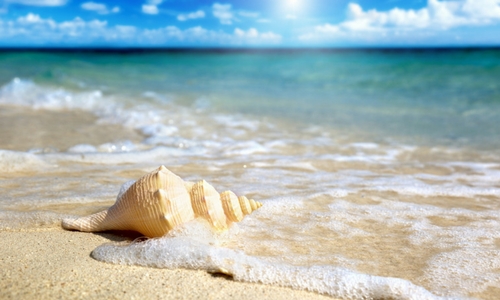
The 60-mile stretch of white-sand beaches that surround Myrtle Beach, commonly known as the Grand Strand, is teeming with souvenirs, and we’re not talking about the abundance of gift shops and beachwear stores. No, these keepsakes are absolutely free and can be found under your feet at the beach. All you have to do is pick them up, and follow these beachcombing tips:
* Know what you are looking for: What makes finding beautiful seashells and other fossils so difficult is distinguishing them from the many fragments of rocks and crushed shells that also wash ashore. Sometimes it can seem like finding a needle in a liquid haystack. But by keeping a keen eye out for the choice shells, such as those of scallops, bubbles and conchs, as well as non-shell treasures, like shark teeth, starfish and sand dollars, you can mentally block out the less-impressive fossils and focus on the good stuff. For example, if you are looking for shark teeth, look for sharp angles that are usually black in color. For sand dollars, look for large, round objects that are often the same color as the sand. But remember, beauty is in the eye of the beholder, so the real keepers are the ones that appeal to you.
* Know when and where to go: Bay View guests can find shells right in their backyard on the beach by simply walking along the shoreline and looking for items rolling in the surf or partially buried in the wet sand, but there’s plenty of competition seeking those same treasures. Every night, the changing tide brings in a fresh batch of new shells unearthed from the seafloor, so if you want to pick up some keepers along the rows of downtown hotels, morning time is your best bet for beating the early birds. The mornings after heavy storms over the ocean are particularly fruitful since the churning currents often stir up some long-buried objects. Of course, the shifting tides bring in more shells throughout the day, so from low tide to rising tide is your best bet for success without visiting some of the more fertile shelling grounds on the Grand Strand.
* Beachcombing hot spots: Sometimes, finding the most shells is a lot like real estate: Location, location, location. Although Mother Nature randomly sends buried treasure ashore at all spots along the beach, the less-populated stretches of coastline have a higher density of keepers simply because the number of beachcombers is smaller. North of Bay View, the “Golden Mile” section of Myrtle Beach between 31st Avenue North and 82nd Avenue North features mainly private beach homes instead of high-rise hotels, so your odds of finding something special are much greater along its coastline. South of Bay View, Myrtle Beach State Park offers a nice stretch of coastline and a nature center where you can join beachcombing expeditions and get help identifying your catches.
* What to bring: The beauty of beachcombing is that no equipment is required — all that’s needed is you, the sand, the shells and a relaxing day on the beach. But there are a few items that can make your experience even better. For starters, a plastic bag or a sand pail are handy for carrying your finds. Some folks wear water shoes so they can walk on a shell bed without discomfort, but barefoot beachcombers like to use their big toes to probe partially exposed shells. Shovels and sifters are used by serious shellers, and those looking for bigger treasure invest in a metal detector for finding lost jewelry, coins and other metals.
After your day of beachcombing, return to Bay View Resort to rest and show off your finds. And if you strike out, you can always take a short walk down the Myrtle Beach Boardwalk to pick out a few souvenirs at the Gay Dolphin, the ultimate place to find shells without all the bending and scooping.

